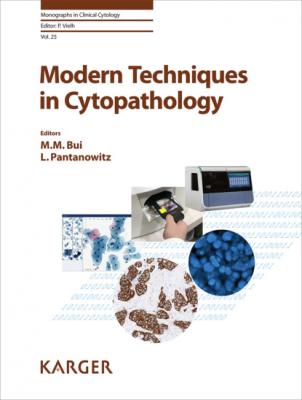ТОП просматриваемых книг сайта:
Modern Techniques in Cytopathology. Группа авторов
Читать онлайн.Название Modern Techniques in Cytopathology
Год выпуска 0
isbn 9783318065763
Автор произведения Группа авторов
Жанр Биология
Серия Monographs in Clinical Cytology
Издательство Ingram
Since most IHC are developed using formalin-fixed paraffin-embedded (FFPE) surgical pathology tissue sections, deviation from this standard may impact IHC staining of cytology cell block sections [32]. Therefore, when alcohol or other non-formalin fixative is used, validation is necessary to confirm IHC results [30]. CACBS uses CytolytTM, a proprietary alcohol-based fixation medium, and formalin is contraindicated with this method’s processor [22]. Results of IHC-processed cell blocks using alcohol and CACBS are variable with some stains demonstrating correlation with FFPE samples and others showing inconsistencies (e.g., lack of staining and/or weaker intensity) [24, 28, 33]. Examples include inconsistent staining for cytokeratin (CK) 7, CK20, WT-1, calretinin, thyroid transcription factor-1 (TTF-1), estrogen receptor, and progesterone receptor [33], among others.
Possible solutions to circumvent this have been described, such as pre-fixation of the sample with formalin followed by a CytoLyt wash prior to placing in PreservCyt [29], or post-fixation of a CACBS-produced slide in formalin [33]. Some of these techniques have shown inconsistencies when studied [30], and further investigation is thus necessary to meet guidelines set forth by the College of American Pathologists (CAP) requiring a minimum of 90% concordance between an existing and new test [34]. The impact of different fixatives is not limited to IHC but may also impact cytochemical or “special stains” such as PAS-D or mucicarmine [24]. Overall, studies indicate that regardless of the fixative and cell block preparation method used, appropriate validation is a crucial component to ensure accurate results.
Cell Blocks: Morphology
The effect on morphology by fixative (alcohol and formalin) and different cell block preparations has been examined. Similar to outcomes reported for cellularity and ancillary studies, these results also vary. In general, alcohol fixation is associated with shrinkage artifacts and better nuclear detail [12]. Some investigators have detected no significant difference between traditional methodology (e.g., HistoGel, plasma-thrombin) and CACBS [21, 28, 30], whilst others have noted a statistically significant improvement in the appearance of the cytoplasm, nucleoli, and chromatin in CACBS-prepared cell blocks [24, 29], attributable to its alcohol-based fixation [33].
Cell Blocks: Evolution, Emerging, and Modern Techniques
The cytology community continues to investigate and explore solutions to provide quality cell blocks that meet the demands of personalized medicine and that overcome the limitations of traditional cell block techniques and CACBS. This has involved revisiting techniques introduced decades ago (i.e., collodion bag), modifying existing ones (i.e., Cell-Gel, AFFECT), and investigating new ones (i.e., XCellent; Fig. 8). The ideal method would generate cell blocks that have high cellularity from capturing all tissue fragments and single cells with minimal cell loss during processing, integrate well with existing methods and workflows, utilize fixation of existing validated methods, not be labor intensive [10], require minimal skill, and be economical. A combination of these features would facilitate standardization across laboratories.
To achieve these milestones, the limitations of existing methods need to be addressed. Low cellularity, one of the most significant deficiencies [7], is typically due to one or more factors – both operator and cytology dependent. In terms of cytology procedures, the inability to capture all of the cells, the lack of a tightly cohesive pellet, and/or dilution by a congealing agent are often reasons for low cellularity in the cell block.
The collodion bag technique, first described in 1993 by Bedrossian et al. [19], has been updated and given the moniker “the Method of Mah” after the cytotechnologist who refined and modernized it [12]. Collodion denotes a syrupy solution. This technique addresses some of the cytology-related shortcomings of more commonly used traditional methods and is particularly well suited for FNA biopsies. In a direct comparison of FNA cell blocks made from saline needle rinses with plasma-thrombin clots, formalin rinses with HistoGel coagulum, and formalin rinses with collodion bags, the collodion bag technique was found to be superior for cell preservation and cellularity [20] (Fig. 9). Rather than using a coagulum, the collodion method traps both free floating cells and tissue fragments in a centrifuged test tube lined by a polymer bag, which is removed, tied off, and submitted in a cassette for routine histology processing.
Briefly, a glass conical test tube is filled with collodion, a commercially available liquid polymer (Cardinal Health Inc., Dublin, OH, USA; Fig. 10). The collodion is then poured out of the test tube, leaving behind a thin lining along the walls of the tube, which is then inverted and allowed to dry completely under a laminar flow hood. This process forms a membrane lining inside the tube. Test tubes can be prepared in large batches and stored for up to a month.
The FNA needle is rinsed into a 10-mL vial of formalin, and the entire sample is poured into the test tube lined with collodion. The test tube is centrifuged to form a pellet. The centrifugal force and osmosis pushes some of the liquid formalin through the collodion membrane lining the tube, allowing it to separate easily from the tube, while trapping the cellular particles inside the bag. The membrane bag is then gently separated from the test tube wall, which forms a collodion membrane bag with the pellet at the bottom of the conical test tube. The bag is gently removed from the test tube. A cotton string is tied around the bag, thereby trapping the pellet at the base of the bag, which is then cut just above the string allowing the remaining supernatant fluid to drain. The bag containing the pellet is placed in a tissue cassette and processed as per routine histology. Working with collodion, an ether-based solvent, requires working in a laminar flow hood and storage in a flameproof cabinet, as the evaporated peroxidases formed from the solvent are flammable [20].

